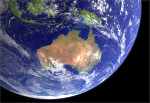THE
ALTONA BEACH BUNGALOW
From 1947,
we had a bungalow in Queen St, at West Altona, a coastal suburb
to the west of Melbourne, which had been made available by my Grandmother (Nana).
It consisted
of a large shed (with a bedroom), kitchen, a caravan (with several beds), and outdoor toilet (with many spiders!). The
kitchen had a wood stove, on which Mum would make scones and dampers, and cook the fish which we caught in Altona Bay. The
origins of the bungalow are uncertain, and we believed that it had belonged to one of the early fishermen in the area.
Dad would attend to the large vegetable garden.
We planted willow trees - these are still flourishing
in the backyard of the house which was bullt on our property after we sold it. We took cuttings from the willow to our new
home in Mont Albert in 1959 - there grew into monstrous trees, two of which survive to the present!
Us kids would be taken out in a small fishing
boat owned by the family who lived in the adjacent house - we caught flathead in Altona Bay!
There was an electricity supply pole at
the front of our property, which is still there!
On the east of our property was a large swamp in which we caught tadpoles and frogs! This
later became Apex Park.
We had that property
until vandals burnt it down in 1959, and then we sold it.
We used to go
there quite often and spend a lot of time there during the Christmas holiday period. Nearby, a great-aunt and great-uncle
lived very close to our bungalow, almost on the beach, and there were many family gatherings with relatives from the country
coming down to visit us and my great aunt and uncle.
One of my mates (Ian) from Primary School would come down
and stay with us occasionally in the late 1940s. In the mid-1950s, my brother and I would take our bikes by train from
Auburn to Altona and ride to the bungalow.
One of my Trainee Technician mates would come down to stay with us in the late 1950s -
we would ride our bikes all the way from Auburn!
Explosives Reserve
About
1 km to the west of our bungalow was the Altona Explosives Reserve, which was built in the early 1940s. There was a Jetty,
at which barges would be towed from Williamstown carrying containers of munitions. These would be off-loaded on to small
tramway trucks, which would then be transported by a horse along a narrow gauge track to underground storage
bunkers.
The reserve was closed down in the late 1950s
and became part of a public park complex. There are a few stumps remaining of the former jetty.
I can recall the railway track, which ran alongside
Queen St before it entered tor reserve.
The Big Explosion
On Sunday February 1 1953 we were staying
at the bungalow and heard a tremendous explosion to the north. We rushed outside, to see a vast plume of smoke rising thousands
of feet into the sky. This turned out to be from the Deer Park munitions factory, a few km to the north of our bungalow. The
noise was heard right across suburban Melbourne!
Radio Monitoring
In the bungalow there were two radios: a stand-up TRF console in a wooden
cabinet of ancient vintage, and a small Astor mantel radio (made around 1940) in a green plastic case.
In 1950, we set
up a wooden pole outside the back door, and ran a simple short antenna wire into the TRF.
The results were
amazing! In mid-summer, in the late afternoon, New Zealand stations were
heard very easily, such as 2YC Wellington 660 and 2YA Wellington
570. This was some five hours before our sunset!
Nothing like
that nowadays!
In those years,
the Melbourne Age newspaper published a weekly Radio Listening Guide (the
forerunner of today’s “Green Guide”), and it also put out a folding large card, about A4 size, in which
all Australian medium-wave stations were listed, with calls, operating times, locations, and other details.
I had pinned
this card to the top of the radio, and ticked off then stations which I had heard.
Rifle Shooting
In 1950, our family friend with his Ford Prefect car visited us often when we were staying at the Bungalow.
He used to drive my bro and I out to the paddocks north of Werribee, a few km away. In those days, the area had not been
residentialized and was mainly volcanic plains, Scotch thistles, lava stones and farms.
Our friend had a .22
cal rifle, which was for destroying rabbits, which in the early 1950s had reached plague proportions. He showed me, as a kid
of ten, how to set up the weapon, prepare znd load the ammo, understand the recoil, and fire it. I became rather good
at this, and killed many rabbits, whilst my bro watched. These animals were everywhere, and had virtually destroyed
the landscape with their burrows.
My accuracy was good up to abut 100 metres Wet then took the carcasses
back to the Bungalow, hanging them on a bar on the front of the car, where I would clean them, and Mum would cook them
up as stews.
Looking back, our friend had no understanding
of safety issues, and I now realize that those activities were extremely dangerous, as a 22 rifle can be
lethal to humans at close range. This weapon
is still used in its millions worldwide, in controlled environments at gun clubs, pest control, the Boy Scouts Movement,
colleges, and self-defence.
and the bullets are about 6 mm diameter.

